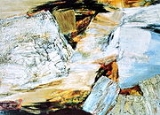
Impasto
Encyclopedia

Painting
Painting is the practice of applying paint, pigment, color or other medium to a surface . The application of the medium is commonly applied to the base with a brush but other objects can be used. In art, the term painting describes both the act and the result of the action. However, painting is...
, where paint
Paint
Paint is any liquid, liquefiable, or mastic composition which after application to a substrate in a thin layer is converted to an opaque solid film. One may also consider the digital mimicry thereof...
is laid on an area of the surface (or the entire canvas
Canvas
Canvas is an extremely heavy-duty plain-woven fabric used for making sails, tents, marquees, backpacks, and other items for which sturdiness is required. It is also popularly used by artists as a painting surface, typically stretched across a wooden frame...
) very thickly, usually thickly enough that the brush
Brush
A brush is a tool with bristles, wire or other filaments, used for cleaning, grooming hair, make up, painting, surface finishing and for many other purposes. It is one of the most basic and versatile tools known to mankind, and the average household may contain several dozen varieties...
or painting-knife strokes are visible. Paint can also be mixed right on the canvas. When dry, impasto provides texture, the paint appears to be coming out of the canvas.
The word "impasto" is Italian
Italian language
Italian is a Romance language spoken mainly in Europe: Italy, Switzerland, San Marino, Vatican City, by minorities in Malta, Monaco, Croatia, Slovenia, France, Libya, Eritrea, and Somalia, and by immigrant communities in the Americas and Australia...
in origin; in that language it means "dough" or "mixture"; the verb "impastare" translates variously as "to knead", or "to paste". Italian usage of "impasto" includes both a painting and a potting technique (see section below on impasto pottery). According to Webster's New World College Dictionary, the root noun of impasto is pasta, whose primary meaning in Italian is paste.
Oil paint
Oil paint
Oil paint is a type of slow-drying paint that consists of particles of pigment suspended in a drying oil, commonly linseed oil. The viscosity of the paint may be modified by the addition of a solvent such as turpentine or white spirit, and varnish may be added to increase the glossiness of the...
is most suitable to the impasto painting technique, due to its thickness and slow drying time. Acrylic paint
Acrylic paint
Acrylic paint is fast drying paint containing pigment suspension in acrylic polymer emulsion. Acrylic paints can be diluted with water, but become water-resistant when dry...
can also be impastoed. Impasto is generally not possible in watercolour or tempera
Tempera
Tempera, also known as egg tempera, is a permanent fast-drying painting medium consisting of colored pigment mixed with a water-soluble binder medium . Tempera also refers to the paintings done in this medium. Tempera paintings are very long lasting, and examples from the 1st centuries AD still exist...
without the addition of thickening agent due to the inherent thinness of these media.
Impastoed paint serves several purposes. First, it makes the light reflect
Reflection (physics)
Reflection is the change in direction of a wavefront at an interface between two differentmedia so that the wavefront returns into the medium from which it originated. Common examples include the reflection of light, sound and water waves...
in a particular way, giving the artist additional control over the play of light on the painting. Second, it can add expressiveness to the painting, the viewer being able to notice the strength and speed applied by the artist. Third, impasto can push a painting into a three dimensional sculptural rendering. The first objective was originally sought by masters such as Rembrandt and Titian
Titian
Tiziano Vecelli or Tiziano Vecellio Tiziano Vecelli or Tiziano Vecellio Tiziano Vecelli or Tiziano Vecellio (c. 1488/1490 – 27 August 1576 better known as Titian was an Italian painter, the most important member of the 16th-century Venetian school. He was born in Pieve di Cadore, near...
, to represent folds in clothes or jewels: it was then juxtaposed with more delicate painting. Much later, the French impressionists created entire canvases of rich impasto textures. Vincent van Gogh
Vincent van Gogh
Vincent Willem van Gogh , and used Brabant dialect in his writing; it is therefore likely that he himself pronounced his name with a Brabant accent: , with a voiced V and palatalized G and gh. In France, where much of his work was produced, it is...
used it frequently for aesthetics and expression. Abstract expressionists such as Hans Hofmann
Hans Hofmann
Hans Hofmann was a German-born American abstract expressionist painter.-Biography:Hofmann was born in Weißenburg, Bavaria on March 21, 1880, the son of Theodor and Franziska Hofmann. When he was six he moved with his family to Munich...
and Willem De Kooning
Willem de Kooning
Willem de Kooning was a Dutch American abstract expressionist artist who was born in Rotterdam, the Netherlands....
also made extensive use of it, motivated in part by a desire to create paintings which dramatically record the "action" of painting itself. Still more recently, Frank Auerbach
Frank Auerbach
Frank Helmut Auerbach is a painter born in Germany although he has been a naturalised British citizen since 1947.-Biography:Auerbach was born in Berlin, the son of Max Auerbach, a patent lawyer, and Charlotte Nora Burchardt, who had trained as an artist...
has used such heavy impasto that some of his paintings become almost three-dimensional.
Because impasto gives texture to the painting, it can be opposed to flat, smooth, or blending techniques.
External links
- Lindberg, Ted. Alfred Currier: Impasto
- National Portrait Gallery, London. http://www.npg.org.uk/collections/explore/glossary-of-art-terms1/impasto.phpImpasto

